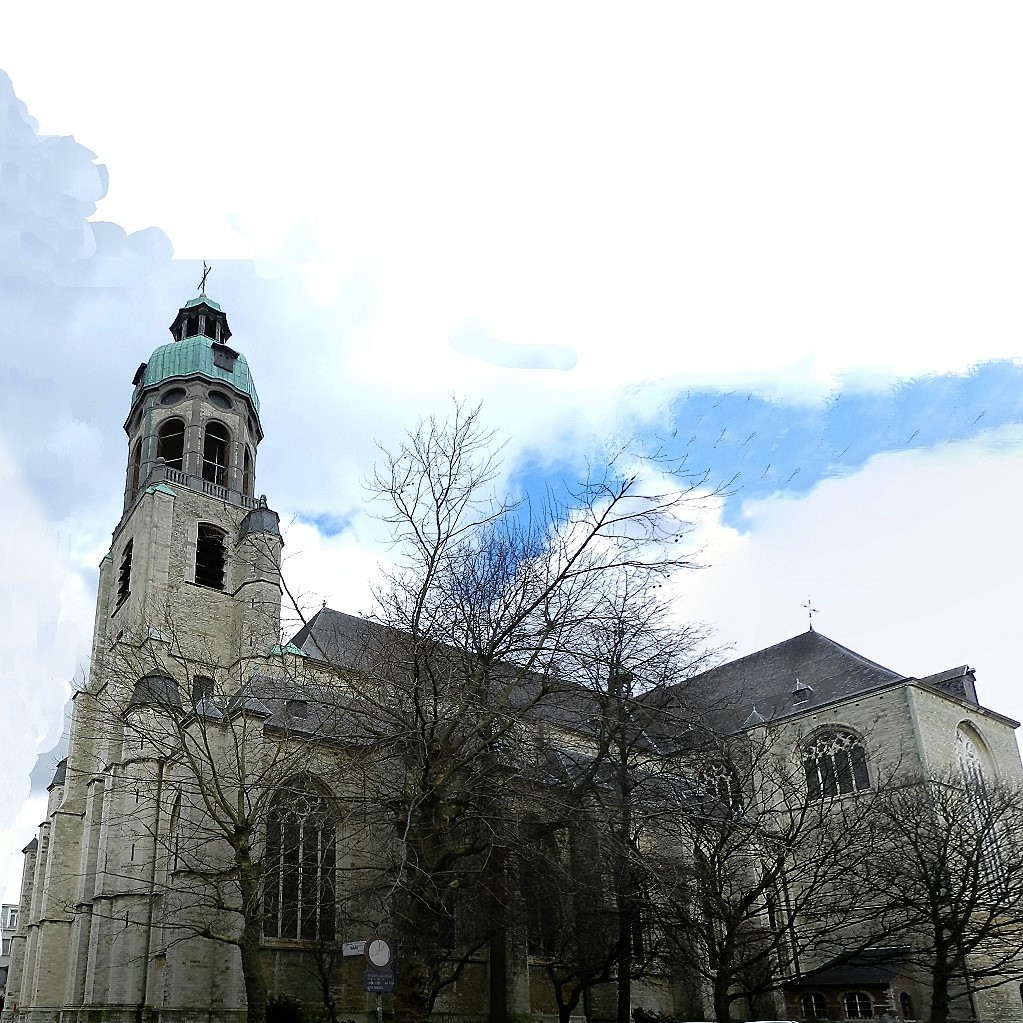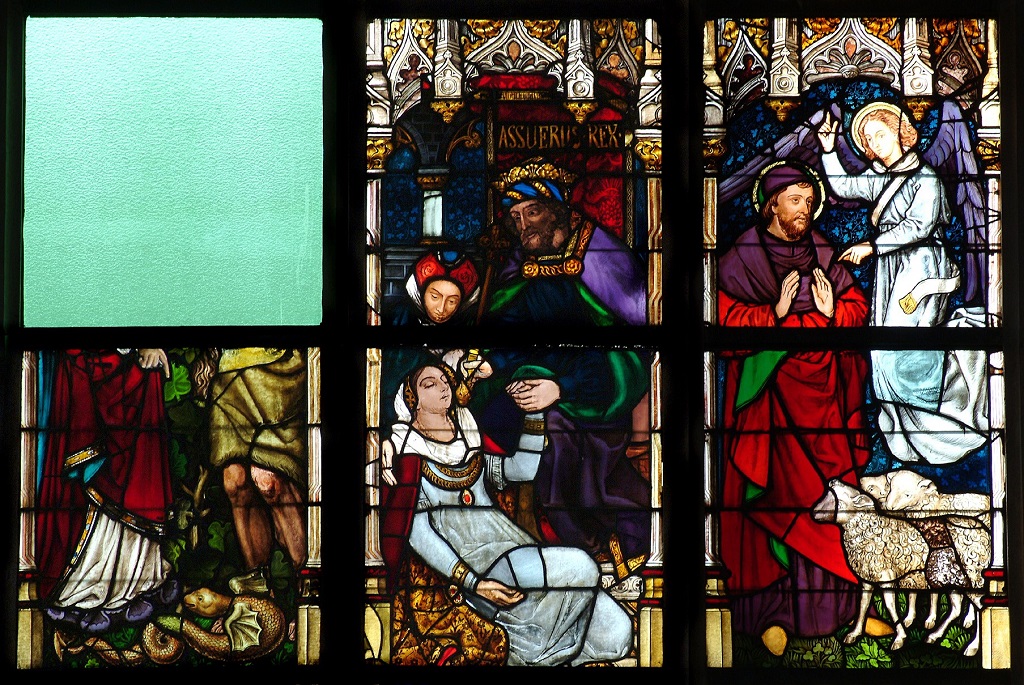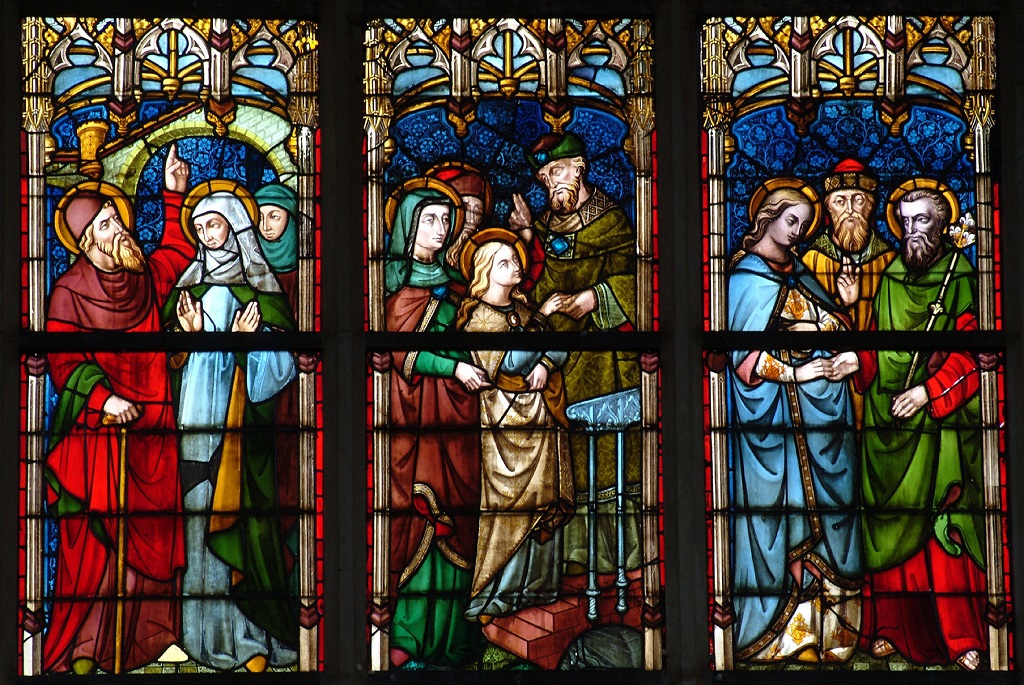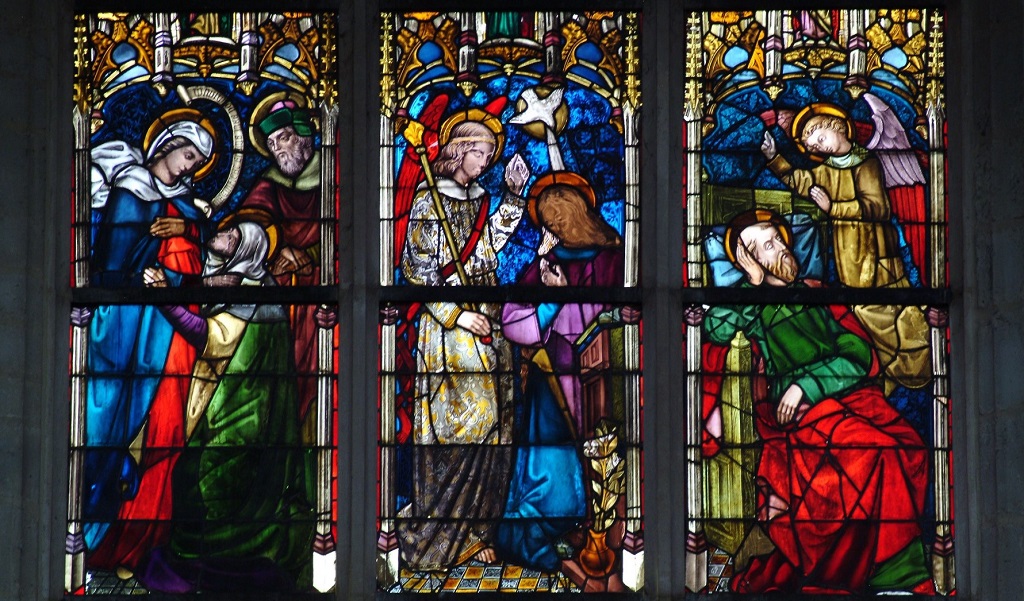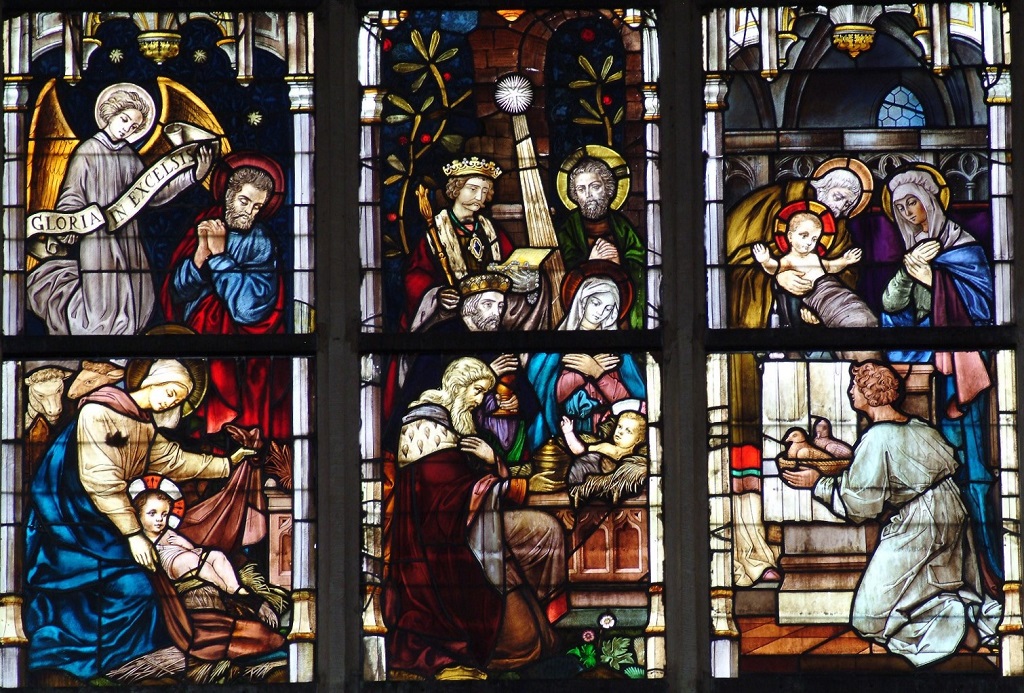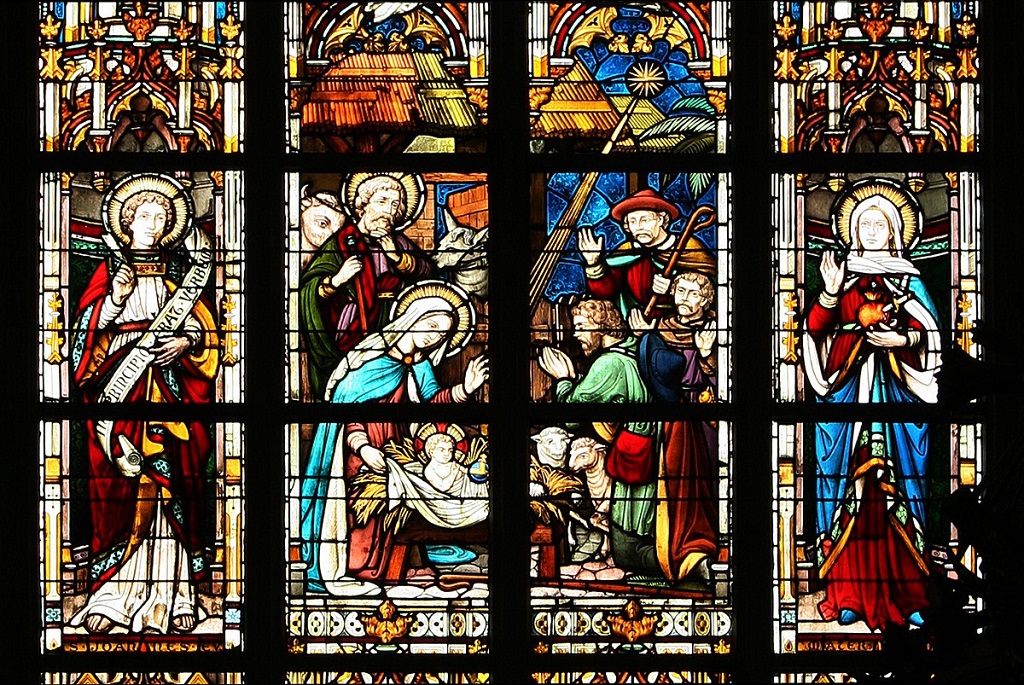Antwerp's St Andrew's Church, a revelation.
The stained glass windows in the southern aisle:
Mary’s election
In the last quarter of the 19th century a series of neo-Gothic stained glass windows were installed in both aisles. They deal with salvation history, which begins with the election of Mary. The theme starts in the southern aisleLengthwise the nave [in exceptional cases also the transept] of the church is divided into aisles. An aisle is the space between two series of pillars or between a series of pillars and the outer wall. Each aisle is divided into bays., develops in western direction and originally continued in the northern aisle, while the way of the cross could already be followed in opposite direction. Each window contains three Biblical scenes, each in a strip of its own and crowned by a Gothic canopy. The patrons have been immortalized in the bottom zone, where their name saints flank an angel with a dedication.
- The fall of the first human couple, with God’s promise of Mary’s Immaculate Conception as an answer.
- Esther before Ahasverus, who is given mercy for her (Jewish) people, which is seen as a prefiguration of Mary in Heaven.
- The revelation to Joachim of the birth of his daughter Mary.
In the tracery angels are holding a banderol with the Biblical greeting: “Ave Maria gratia [plena, Domi]nus tecum // benedicta tu in mulieribus” (“Hail, Mary, full of grace, the Lord is with you, blessedUsed of a person who has been beatified. Beatification precedes canonisation and means likewise that the Church recognises that this deceased person has lived a particularly righteous and faithful life. Like a saint, he/she may be venerated (not worshipped). Some beatified people are never canonised, usually because they have only a local significance. are you among women” (Lk. 1:28.42b).
The patron saints of Lodewijk Liebrechts and his wife Elisabeth Van der Buecken are Louis of France and Elisabeth of Thuringia.
- Joachim and Anna, Mary’s parents.
- The Presentation of Mary: since her childhood Mary devoted herself to God in the Temple, at least according to apocryphal texts.
- The wedding of Mary and Joseph
In the tracery Mary and the Infant Jesus are honoured by angels with a verse from Ps. 148 on the banderol:
- “laudent nomen Domini” (v.12c) (“Let them praise the name of the Lord”)
- “quia exaltatum est nomen eius solius” (v.13) (“for his Name alone is exalted”)
- “confessio eius super caelum et terram” (v.14a) (“his splendour is above the earth and the heavens.”)
- “et exaltavit cornu populi sui” (v.14b) (“And He has raised up for his people a horn”); the horn is a symbol of power, self-awareness, prestige.
Church wardenA lay person who is a member of the fabric committee. In this position, he/she is co-responsible for the material and financial management of the building and all the church’s property. count Gerard le Grelle and his spouse Anna Van Lancker donated the stained glass window on the occasion of their fiftieth wedding anniversary. Their patron saints are Gerardus, with a helmet, an abbot’s crosier and a church model, and Anna teaching Mary. The text in the book (Is. 7:14) predicts that Mary will be the mother of God’s son: “Ec[ce Vir]go conci: [= piet]// et pariet filium”. The armour of the le Grelle family, with the letters “AAA”, can be interpreted as “Amor ardorem auget” (“Love deepens daring desires”).
Each main scene is crowned with a Gothic canopy with a niche. In it is the figure of a prophet with a banderol of which the text is related to the scene.
- The Annunciation (due to incorrect restauration this scene is now in the second instead of in the first strip)
Mary is taken by surprise by the angel Gabriel. During his discourse he points to Heaven, from where the allegoric dove of the Holy SpiritThe active power of God in people. It inspires people to make God present in the world. Jesus was ‘filled with the Holy Spirit’ and thus showed in his speech and actions what God is like. People who allow the Holy Spirit to work in them also speak and act like God and Jesus at those moments. See also ‘Pentecost’. sends its rays to Mary.
The prophet quotes Isiah 7:14: “Ecce virgo conc[i]piet” (the virgin shall be with child), which is also part of the text of the communio at the Feast of the Annunciation. This text is also repeated in the message the angel gives to Joseph in his dream (Mth. 1:23).
- Mary’s visitation to her cousin Elisabeth
Mary’s aureole functions as a comic strip balloon: “Magnificat anima mea Dominum” (My soul proclaims the greatness of the Lord).
In the prophet Isiah’s call (40:3), “Para viam Domini” (prepare the way of the Lord), John the Baptist recognized himself, according to Mth. 3:3, Lk. 3:4 and John 1:23 and Lk. 1:76. He is “the infant” that “leaped for joy” in Elisabeth’s womb (Lk. 1:44).
- The angel appears to Joseph
It is as if Joseph has fallen asleep pondering, sitting on a Gothic seat (Mth.1:20-24). The man with the banderol prompts to turn to Joseph when in need: “Ite ad Joseph”.
The angels in the tracery are holding banderols, left with “Ave Maria, gratia plena, Dns [= Dominus] tecum”, right with “Benedicta Tu in mulieribus” (Hail Mary, full of grace, the Lord is with you. Blessed are you among women).
The patron saints of the donators, Ferdinand Meeus and his wife Theresia Hubertina Peeters, are Ferdinand of Castile and Theresia of Avila. Ferdinand’s key refers to the reconquest of Seville in 1248 and carries the text: “Dios abrira // rey entrara” (God opens, the king enters). The flag is the one of Castile and Léon. Theresia’s pining heart is touched by the allegorical arrow of God’s love.
The birth of Christ
The naked Infant Jesus is lying on a sheaf of straw. Mother Mary kneels down to slightly lift the cloth that covers the manger, protecting against the cold, and to show her little Child. Joseph is standing on the right with his hands crossed in front of his chest. In the night blue star-spangled sky three stars twinkle and an angel with yellow wings is gliding; in his hands he is carrying a banderol with on it the words: “Gloria in excelsis [Deo]” (“Glory [to God] in the highest heaven”). The text continues across the panes of the tracery: “et in terra pax hominibus bonae voluntatis” (“and on earth peace to those on whom his favour rests”): this is the essence of ChristmasThe feast commemorating the birth of Jesus. It is always celebrated on December 25..
The adoration of the Magii
Jesus, a child that seems already older, blesses his visitors. Here the tradition of the three ages is followed. 1) The eldest of the three kings, balding and with a long beard, is kneeling before Him. He has laid down his crown and offers Him a golden vase. 2) The second king, middle-aged, with a full beard and luxuriant hair, is still wearing his crown, is also kneeling and holding a vase. 3) The youngest king, with only a moustache and brown wavy hair, is wearing a crown and carrying a sceptre. He is holding an open casket full of jewels, but does not kneel. The whole is lit by the star that “stopped over the place where the child was.”
The presentation of Jesus in the Temple
The Jewish Temple has been interpreted as a Gothic church. Old Simeon is holding little Jesus in front of him. In the foreground a young man is kneeling to offer his basket with two doves. You would be tempted to identify him with Joseph, but he is too young. He is wearing a kind of Temple servant’s albA long white robe with long sleeves, worn during religious ceremonies by priests, deacons, pastoral workers, altar servers and acolytes. and the aureole, which Simeon does have, is missing. On the altarThe altar is the central piece of furniture used in the Eucharist. Originally, an altar used to be a sacrificial table. This fits in with the theological view that Jesus sacrificed himself, through his death on the cross, to redeem mankind, as symbolically depicted in the painting “The Adoration of the Lamb” by the Van Eyck brothers. In modern times the altar is often described as “the table of the Lord”. Here the altar refers to the table at which Jesus and his disciples were seated at the institution of the Eucharist during the Last Supper. Just as Jesus and his disciples did then, the priest and the faithful gather around this table with bread and wine. a burning candle refers to Simeon’s words: “My eyes have seen Your salvation (…) a light for revelation to the Gentiles” (Lk. 2:32). This phrase has inspired Catholics to hold the ritual candle procession when celebrating Jesus’s presentation on February 2nd; hence the popular name of the feast: Candlemass.
The patron saints of vicarAccording to Canon Law, a vicar is a substitute of a minister. In a diocese, several vicars assist a bishop: priests who look after a certain policy area within the diocese (parishes, liturgy, etc.). Henricus Gallis and Joanna Danco are Holy Roman Emperor Henry II and queen Joan of France (1464-1504), who was the foundress of the Annonciades and so is wearing the habitGeneral name for the typical clothing of a particular religious order.
A long-sleeved, unbuttoned robe down to the feet, usually with a hood attached. This attire is typical of monks and nuns.
of this order: a red scapularA shoulder garment consisting of a piece of cloth the width of the shoulders, with an opening for the head and covering the entire front and back of a habit. It is worn by various religious orders, including Trappists, Carmelites, Alexians, … over a light blue and grey robe, a white wimple, a black veilHeadgear worn by female religious. Until the Second Vatican Council, all nuns wore wimples, which covered the entire hair and neck. Nowadays, the veil is usually worn on the hair. and a white cope. The cup with wine and a basket with bread refer to her charity.
In the foreground Mary is lying on a primitive childbed. With both hands she is holding her baby by her chest. Joseph is standing next to her and is holding a large white cloth to protect the child from the draught. At the left shepherds enter the barn. They have lambs and other gifts with them. Their flock of sheep is inside a fence on the extreme right, above the roof of the stable. On the right, behind Mary, the grey donkey is eating from a sheaf of hay. A sturdy, ochre brown ox fills the entire left foreground. True to tradition it is looking at its Master, which does not prevent it from grazing, judging from the juicy green grass in its muzzle, across which there is a bridle.
Refers to the brotherhood of this name.
